Abstract
At present, sustainable design is experiencing energy consumption and cost-effectiveness challenges in the building industry. A recent body of literature argues that the development of emerging smart digital technologies, such as Building Information Management (BIM) and blockchain (BC), offer immediate benefits to the industry. However, the current application of BIM and BC in the sustainable design and construction process focuses on smart energy and construction management, with little attention to addressing challenges for applying BIM to sustainable design and proposing strategies in terms of the usability of these technologies in the management of building construction projects. Therefore, this paper sets out to explore the potential roles of an integrated BIM and BC approach for sustainable building design information management. The first attempt is presented to use BC aided BIM for sustainable building design coordination and collaboration in multiple building stages. BC has the potential to address challenges that hinder the industry from using BIM for sustainable design, which has been unearthed. An innovative BC enhanced transaction process in BIM is required for sustainable building development. Roles of a user level driven smart contract system of BC can be used to enhance BIM system in the sustainable buildings process. The role of BC is primarily at user level driven smart contracts and their record value exchange capabilities. A user level (BIM stakeholders) driven BC technology for transaction in BIM process flow is revealed, and the user level (sustainable building design project stakeholders/BIM clients) driven and the smart contract enabled BIM+ BC architecture to address challenges of BIM for sustainable design has been further circulated according to the literature. Subsequently, a conceptual architecture of BIM + BC for Sustainable Building Design Information Management Framework in building project management has been proposed, validated, and refined. The Framework has two level encompassing structures and flow. The high-level framework is focused on strategy, whilst the low-level framework demonstrates technical components in detail. This architecture supporting project stakeholders in managing information, has the potential to achieve and ensure the realization of sustainable design goals through the interactive realization of smart contracts integrated into the user level driven BIM + BC system and its recording value exchange function through three user-driven levels, namely user, system, and transaction.
1. Introduction
Sustainable building design is no longer an emerging topic. The understanding of architecture design in the construction industry has expanded from the relationship between ‘building and user’ to a comprehensive reflection on the macroscopic system of ‘natural environment, building and people’ [1]. The meaning of building environmental sustainability far exceeds the level of building energy efficiency and cost performance. Users are the core of architecture design, and the integration of architecture design and users becomes the foundation of the future of sustainable development [2]. Sustainable design respects the environment and climate characteristics of the site and pursues the health of the physical environment and microclimate, such as wind, light, heat, sound, and water, seeking the interaction of environment, building and user. The role of users is strictly connected to environmental comfort and energy savings, which means that the design of buildings requires to take into account the role of users in sustainable building design [3]. By focusing on the building, the combination of functional diversity and individuality, reducing the need for resources and material exchange between buildings and the environment, sustainable development can be promoted.
With the development of digital technologies, such as Building Information Management (BIM), and smart digital technology, e.g., blockchain, Artificial Intelligence (AI) and big data, the industrial digitization era is gradually approaching. The digital age, such as industry 4.0, is constantly updating users’ cognition and lifestyles, and at the same time bringing about more efficient working methods. Digital technology can not only improve people’s environmental requirements for the living, but also enhance the quality of the design. This is mainly because digital technology can scientifically survey and predict natural and human conditions in the area where the building is located, thereby enhancing people’s living requirements [4].
From the whole building design process, the application of digital technology in the field of building design mainly has the following four aspects [5]:
- Conceptual Analysis of Conceptual Design. The Computer Aided Design (CAD) design software aids the designer’s ideas to be converted into digital models for presenting design concept and as an authoring tool in BIM.
- Optimization Analysis of Scheme Design. The design software is used to analyze and predict the design indicators, attributes and functions that can be collected and quantified in the scheme design, so as to feedback, modify and optimize the Scheme Design.
- Technical Analysis of Standardized Design. Designers can use the provided CAD building standard library to enhance design outputs.
- Feasibility Analysis of Project Bidding. The use of computer data information processing capabilities for text and image processing of documents, can realize the analysis and prediction of the feasibility and rationality of building project bidding.
For the time being, the full digitalization of the construction industry is still in its infancy. However, with the advent of technologies such as BIM+ smart digital technology, all participants, elements and whole process management of building design and construction can cooperate with each other on a common platform. In the original fragmented construction industry, its production, business and management levels can also be effectively integrated, project data and management information are also interconnected, and the era of sustainable building design and construction under the BIM+ smart digital technology will also come.
2. Background
2.1. Building Information Management (BIM) for Sustainable Design
In sustainable building design, BIM is a technology that uses a 3D model to build a set of project database, through the retrieval and application of information, to achieve a sustainable goal over the whole life cycle of the project [6].
2.1.1. User Level Driven BIM for Sustainable Design
With the introduction of BIM technology, the user level key players, such as architects, structural and building service engineers, and other discipline designers, even the client, can use the same BIM model for sustainable building design and planning. The model serves as a ‘single version of the truth’. In addition, different users can view the building information through 3D visualization. In addition to the size, location, relative spatial relationship and other information, the model can serve as a central index, which links to further information of material, quantity and cost to achieve goals of sustainable building design [6,7], The user level driven BIM for sustainable design information management is illustrated in Figure 1.
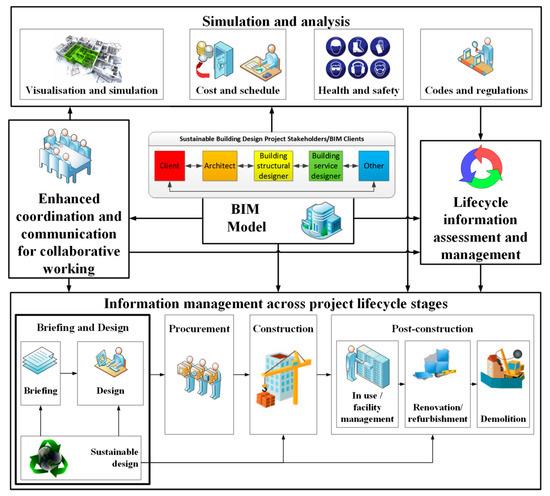
Figure 1.
The user level driven Building Information Management (BIM) for sustainable design information management (devised by the authors based on the literature).
2.1.2. BIM Advantages for Sustainable Building Design
The advantages of BIM for sustainable building design have been researched [6,8], and include:
- Three-Dimensional (3D) Model Visualization by clearly conveying the design concept through 3D model visualization, designers can reduce communication inadequacies among the design team, and improve the design quality.
- Model Transition and Collaboration. All the information in the 3D Model can be directly transmitted and collaboratively used without inputting repeated data, which can reduce human errors and improve work efficiency.
- 3D Model Simulation and Clash Detection. The use of 3D BIM simulation and clash detection capabilities enable the project team to verify the design, reduce the risk of engineering application, eliminate unnecessary time and material waste, and reduce costs.
- Design Information for Building Life Cycle. Design information across the building life cycle stages can be used for construction and operation, even for future facility management to minimize waste.
- Smart Digital Technology Enhanced BIM. BIM+ smart digital technology will revolutionize engineering simulation and design. In the future, BIM+ smart digital technology will speed up the development cycle of building design products and services, from a few days in the past to a few months now. At the same time, the technology provides a mode of rapid innovation design in the process of product and service characteristics, performance and cost, thus endowing sustainable design with new ways.
2.1.3. The Potential Challenges for BIM Implementation in Sustainable Design
There are potential challenges for BIM implementation in sustainable building design in terms of legal barriers and model ownership:
- BIM Implementation Risks. The BIM implementation includes a series of risks, including technical, management, environmental, financial and legal risks [9].
- Intellectual Property and Cyber Security. Intellectual property and cyber security results of BIM tools [10,11].
- Reuse and Adoption Strategies for BIM Models. Development of comprehensive and clear reuse and adoption strategies for BIM models [9].
- Level of Responsibility. BIM’s integration concept blurs the level of responsibility between different project team members [12], and trust in collaboration [13].
- BIM Contract. A new form of contract for BIM to sustainable building design implementation concerning BIM responsibilities, limitations and liabilities [12].
2.1.4. The Blockchain Potential Role for BIM
BIM aimed at sustainable building design is based on the information life, intelligent methods and processes of the construction project life cycle. In short, it is the intelligence of design process information. The essence of BIM is the application of data mining. Combined with the application and development of intelligent technologies such as blockchain, BIM can better integrate data and resources and establish clear responsibilities and contractual relationships [13,14,15]. Therefore, blockchain enhanced BIM implementation could assist to address the above-mentioned challenges in sustainable building design for managing information of the project, which is the focus of this paper.
2.2. Blockchain
Blockchain is a series of data blocks generated by cryptography [16]. It is a new application mode of computer technology such as distributed data storage, point-to-point transmission, consensus mechanism, and encryption algorithm [17]. The key innovation of blockchain technology is that it allows its participants to transfer assets over the internet without centralized third parties [18].
2.2.1. Blockchain Characteristics
Blockchain has the following characteristics [17]:
- Decentralization. There is no intermediary, and equal rights and obligations of all nodes.
- Traceability. Fraud reduction and trust and accountability.
- Sharing. The more organizations, companies and even competitors involved, the more streamlined the process and the higher the value.
- Prohibition of Tampering. Update or delete is not allowed.
Therefore, the blockchain is a decentralized database that records transactions in a chronological and secure manner. Thus, blockchain transactions can further represent a transfer of value to systems. This value can be a service, a product, or an approval in the form of a smart contract [19].
2.2.2. Implementation Conditions of Blockchain Technology
Blockchain is not a one-stop solution to all the problems that arise in data and asset transactions. In the following five blockchain standards, only three or more of them are met, the project can be considered to need blockchain technology [20]:
- Multi-party Data Update Requirement. There is a multi-party data update requirement where operations performed by multiple participants need to be logged.
- Validation Requirement. There is a validation requirement, when it is necessary to build trust between the parties and make them understand that their actions are documented.
- Intermediary Requirement of the Project. The project requires one or more intermediaries, which adds cost and complexity.
- Time-limited of Transaction. The transaction is time-limited, that is, the time delay will affect the business.
- Interaction Requirement of Transaction. Transactions require interaction, that is, projects are created by the interaction of multiple participants and depend on their interactions.
As the sustainable building design and construction project involves a number of project stakeholders, project time and cost, as such the blockchain technology can be implemented for the project.
2.2.3. The Blockchain Potential to Overcome BIM Adoption Challenges
At present, the main applications of blockchain in the process of sustainable building design and construction projects focus on: BIM workflow [21], the future life framework driven by network [22], building construction management [14], construction material allocation policies [23], greening supply chains [24], digital built Internet of Things (IoT) ecosystem [25], and smart energy systems, such as digital intelligent transition of urban energy systems [26], up-scaling energy control from building to districts [27], urban energy systems and the transition to zero carbon [28]. There are a few established roles for the use of blockchain to overcome BIM adoption challenges for sustainable building design information management is absent in the literature. Therefore, this paper set out to explore the potential roles of blockchain in BIM for sustainable building design information management.
3. Roles of User Level Driven Blockchain in BIM for Sustainable Design Information Management
3.1. User Driven Smart Contract
The BIM model consists of smart objects [29] that represent physical elements, such as doors and columns, and encapsulate intelligent objects [30]. Object intelligence, also known as semantic enrichment [30] and the flow of data between BIM stakeholders [31], such as architects, structural and building service engineers. Figure 2 illustrates the architecture of this interaction between the user level (BIM stakeholders) driven database of BIM/Smart objects that contains BIM specification and building objects including wall, window, column, door, and other objects, which the BIM specification can be associated with in two levels, i.e., data (Wall(Wa), Window(Wi), Column(Co), Door(Do), and Other(Ot)), and document specification (Wa1, Wa2, Wa3, and WaN).
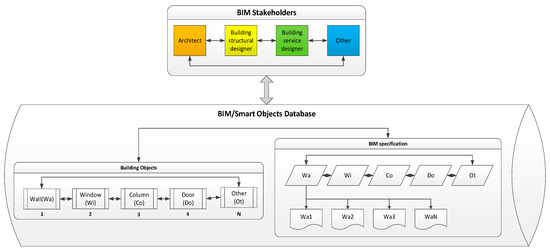
Figure 2.
The architecture of the interaction between the user level (BIM stakeholders) driven database of BIM/Smart objects in information management of building construction projects (devised by the authors based on the literature).
One of the most important roles of blockchain is the smart contract approach. A smart contract is a computer program that applies to the if/then principle [32]. For example, an inspection is required if the architect or structural engineer design a wall using BIM. If the person responsible for the inspection agrees that it meets an acceptable quality, then the architect or structural engineer will get paid. In the case of blockchain, which can be mortgaged in cryptocurrency, smart contracts can be used in this case. It is safe because cryptography is used in the blockchain to store transactions in blocks of data that are replicated across multiple servers/computers around the world. This user level (BIM stakeholders) driven blockchain technology for transaction in BIM process flow is shown in Figure 3, in which the building design elements/issues for the transaction to BIM stakeholders are via the interactions among the BIM stakeholders, blockchain processor facilitated by cryptography of smart contract, and BIM/Smart objects database enhanced by BIM documentation/specification that is enabled by cryptocurrency of the cryptography. Combining BIM with blockchain technology can also facilitate the use of smart contracts, a computerized trading protocol designed to enforce project terms, replacing mutual trust in third-party ‘intermediaries’.
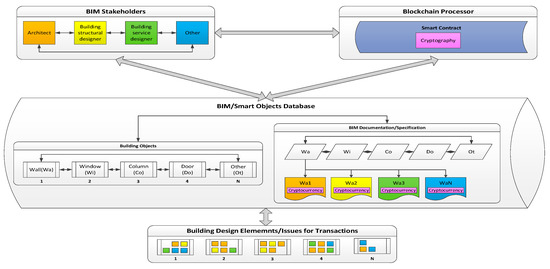
Figure 3.
The user level (BIM stakeholders) driven blockchain (BC) technology for transaction in BIM process flow in information management of building construction projects (devised by the authors based on the literature).
Smart Contract enabled BIM to address the potential challenges of BIM for sustainable design. Through the entire design-lead construction phase, using smart contracts to negotiate editing permissions and store immutable common modification records, the blockchain can serve as a useful tool for managing and documenting changes to BIM models. As shown in Figure 4, the smart contract enabled BIM+ blockchain perfectly solves four of the potential challenges of BIM for sustainable design mentioned in the previous section: technical, management, environmental, financial and legal risks; intellectual property and cyber security; level of responsibility between different project team members; and a new form of contract concerning BIM responsibilities, limitations and liabilities. The smart contract enabled BIM+ blockchain process flow to address the potential challenges of BIM for sustainable design, is structured in a top-down flow that is driven by sustainable building design project stakeholders/BIM clients, such as client, architect, building structural designer, building service designer and other professionals, and through the process of blockchain for transaction in BIM (Figure 3).
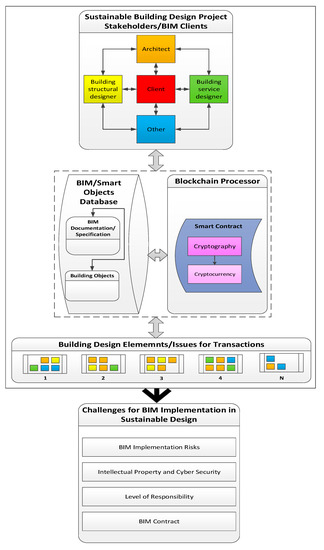
Figure 4.
The user level (sustainable building design project stakeholders/BIM clients) driven and the smart contract enabled BIM+ blockchain architecture to address four of the potential challenges of BIM for sustainable design in information management of building construction project management, such as BIM Implementation Risks, Intellectual Property and Cyber Security, Level of Responsibility, and BIM Contract (devised by the authors based on the literature).
Record Value Exchange Function of the Smart Contract. In addition, the record value exchange function of the smart contract [33], through the sustainability information of the materials set in the BIM tool during the design phase, can help to verify the sustainability of the materials used by the contractor during the construction phase, thereby solving the development of comprehensive and clear reuse and adoption strategies for BIM models, which is one of the potential challenges of applying BIM to sustainable design. Based on the user level (sustainable building design project stakeholders/BIM clients) driven and the smart contract enabled BIM+ blockchain architecture to address four of the potential challenges of BIM for sustainable design (Figure 4), the Architecture is further developed, as shown in Figure 5, to assist Reuse and Adoption Strategies for BIM Models that is another challenge of BIM for sustainable design. The record value exchange function has been added in the updated Architecture, which enabled sustainability, such as material, within BIM documentation/specification and building objects of BIM/Smart objects database that is associated with sustainable design in information management across project lifecycle stages. As such, the sustainable building design material issue for transactions can be created by a contractor with other sustainable building design project stakeholders/BIM clients across project lifecycle stages, such as briefing and design, procurement, construction, and post-construction. Specifically, the ability to reduce costs may be the greatest possible benefit of integrating blockchain for sustainable design, without affecting labor practices or purchasing materials from unscrupulous suppliers.
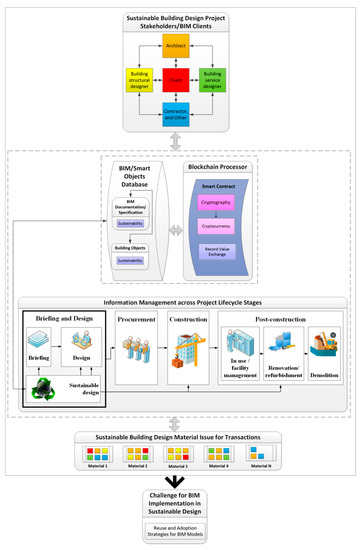
Figure 5.
The updated user level (sustainable building design project stakeholders/BIM clients) driven and the smart contract enabled BIM+ blockchain architecture to address a challenge of BIM for sustainable design in information management of building construction project management, i.e., reuse and adoption strategies for BIM models (devised by the authors based on the literature).
3.2. The Conceptual Architecture of User Level Driven BIM+ Blockchain for Sustainable Design
Based on the BIM Framework for assisting sustainable building design (waste) proposed by Liu et al. [6], as shown in Figure 6, and combined with the above mentioned potential enablers for applying BIM+ blockchain for addressing BIM in sustainable design, a conceptual architecture of BIM+ blockchain smart contract transactions for sustainable building design in information management of the building project is proposed, as shown in Figure 7.
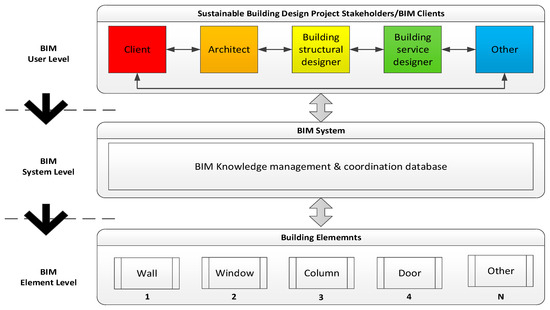
Figure 6.
The user level driven BIM system for sustainable building design in information management of building construction project management (devised by the authors).
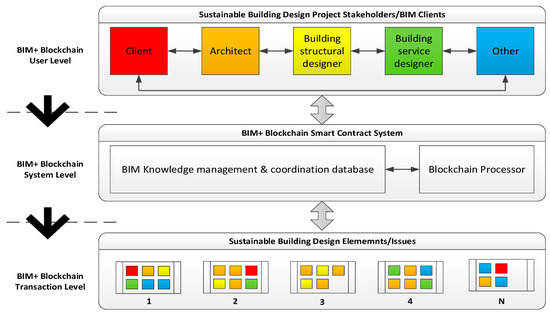
Figure 7.
The conceptual architecture of user level driven BIM+ blockchain smart contract transactions for sustainable building design in information management of building construction project management (devised by the authors).
This draft Building Information Modeling and blockchain (BIM + BC) Sustainable Design Framework emphasizes the responsibilities and values that are handled in smart contract form at the system level through information exchange, communication and coordination at the user level, i.e., through BIM knowledge management and coordination database integrated with blockchain processor. The interaction between the two levels is passed to and interacted with the transaction level for the transaction and security of responsibilities and value for sustainable design elements such as building materials, energy, and water to achieve and secure sustainable goals.
4. Validation and Refinement of the Conceptual Architecture of User Level Driven BIM+ Blockchain Smart Contract Transactions for Sustainable Building Design
The draft user level driven BIM + BC for Sustainable Building Design Information Management Framework (refer to Figure 7) has been presented [34] and validated by industry experts and academics on 2019 Symposium on Blockchain Technology and Application, Hong Kong [35]. The experts and academics suggested that the further detailed explanation of the draft Framework can help with clear understanding of the proposed approach to a wider audience.
Therefore, the following items have been added to enhance the Framework:
- Figure 1 is added to show the user level driven BIM for sustainable design.
- The architecture of the interaction between the user level (BIM stakeholders) driven database of BIM/Smart objects is illustrated in Figure 2.
- Figure 3 is used for further explanation of the user level (BIM stakeholders) driven blockchain technology for transaction in BIM process flow.
- Figure 6 is adopted for the structural flow of the user level driven BIM system for sustainable building design.
- To self of the draft user level driven BIM+BC Sustainable Design Framework in information management of building construction project management (refer to Figure 7), key issues have been added into the Framework components: BIM Knowledge Management & Coordination Database (containing Information Management across Project Lifecycle Stages associated with BIM/Smart Objects Database that has two interactive components, i.e., BIM Documentation/Specification, and Building Objects), and Blockchain Processor (including Cryptography and Record Value Exchange). Hence, the High Level of the BIM+BC for Sustainable Design Framework is shown in Figure 8, which is the refined draft Framework.
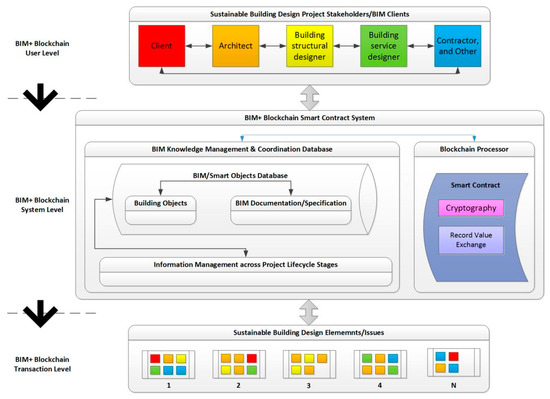 Figure 8. The High Level of BIM + BC for Sustainable Building Design Information Management Framework (devised by the authors).
Figure 8. The High Level of BIM + BC for Sustainable Building Design Information Management Framework (devised by the authors). - In line with Figure 3 and Figure 5, the Low Level of the BIM+BC for Sustainable Design Framework is portrayed in Figure 9, which is focused on illustrating elements of BIM Knowledge Management & Coordination Database of BIM+ Blockchain Smart Contract System in BIM+ BC system level of the Framework (Figure 8).
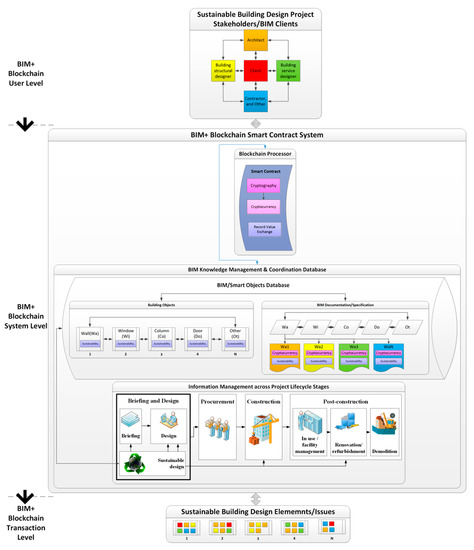 Figure 9. The Low Level of BIM+BC for Sustainable Building Design Information Management Framework (devised by the authors).
Figure 9. The Low Level of BIM+BC for Sustainable Building Design Information Management Framework (devised by the authors).
Therefore, the refined BIM+BC for Sustainable Building Design Information Management has two levels encompassing structure and flow, of which the high-level framework is focused on strategy whilst the low-level framework demonstrates technical components in detail.
5. Discussion and Conclusions
At present, sustainable design aiming at sustainable development is experiencing energy consumption and cost-effectiveness challenges in the building industry. The development of emerging smart digital technologies, such as BIM and blockchain, brings immediate benefits to the industry. However, the main application of BIM+ blockchain for sustainable building design and construction process focuses on the application of smart energy and construction management, with little attention to addressing challenges for applying BIM to sustainable building design and proposing strategies for sustainability goals, which is essential to the integration of blockchain and BIM that sustainable building design requires to consider the role of users who are core players of smart blockchain technology for building construction project management.
This paper is the first attempt to present the use of blockchain-aided BIM for sustainable building design coordination and collaboration in multiple building life cycle stages. This employed ground theory construction method to establish strategies for overcoming blockchain challenges of applying BIM to sustainable building design, and validated and refined via a conceptual architecture of BIM+ blockchain smart contract transactions for sustainable building design Framework in building project management. The blockchain has the potential to solve challenges that hinder the use of BIM for sustainable building design. This includes technical, management, environmental, financial and legal risks; intellectual property and cyber security; level of responsibility between different project team members; a new form of contract concerning BIM responsibilities, limitations and liabilities; and the development of comprehensive and clear reuse and adoption strategies for BIM models. The potential of the blockchain has been unearthed. An innovative blockchain enhanced transaction process in BIM is required for sustainable building development. The role of a user level driven smart contract system of blockchain can be used to enhance BIM system in the sustainable buildings process. Its role is primarily at the core role of smart contracts and their record value exchange capabilities. Subsequently, a conceptual architecture of BIM+ blockchain smart contract transactions for sustainable building design framework in information management of building construction project management has been proposed, validated and refined, which has two level of structure and flow, of which the high-level framework is focused on strategy whilst the low-level framework demonstrates technical components in detail. This architecture supporting project stakeholders in managing information, has the potential to achieve and ensure the realization of sustainable design goals through the interactive realization of smart contracts integrated into the user level driven BIM+ blockchain system and its recording value exchange function through three user-driven levels, namely user, system and transaction. Future research needs to further evaluate and detail the proposed architecture, and develop a set of designer-operable practical framework covering the entire design phase.
Author Contributions
Conceptualization, Z.L. and L.J.; Methodology, Z.L. and M.O.; Software, Z.L.; Validation, Z.L.; Formal analysis, Z.L. and L.J.; Investigation, Z.L. and L.J.; Resources, Z.L. and L.J.; Data curation, Z.L.; Writing—original draft preparation, Z.L.; Writing—review and editing, Z.L., L.J., M.O. and P.D.; Visualization, Z.L.; Supervision, Z.L.; Project administration, Z.L.; Funding acquisition, Z.L. and L.J.
Funding
This research was funded by South China University of Technology, Guangzhou, China, grant number x2sj/K5180600, and Guangdong University Students Innovation and Entrepreneurship Education Research Center grant number 2018A100402.
Acknowledgments
The authors wish to thank all the people who provided their time and efforts for the investigation especially industry experts and academics who validated the Framework from 2019 Symposium on Blockchain Technology and Application, Hong Kong. Z.L. would like to thank Baldur’s Gate I & II by BioWare that brought him out of his fuzzy period many years ago, which is the same with current Smart Blockchain Technology to BIM in terms of the role of user.
Conflicts of Interest
The authors declare no conflict of interest. The funders had no role in the design of the study; in the collection, analyses, or interpretation of data; in the writing of the manuscript, or in the decision to publish the results.
References
- McLennan, J.F. The Philosophy of Sustainable Design: The Future of Architecture; Ecotone LLC: Kansas City, MO, USA, 2004. [Google Scholar]
- Farr, D. Sustainable Urbanism: Urban Design with Nature; John Wiley & Sons: Hoboken, NJ, USA, 2011. [Google Scholar]
- Roberti, F.; Oberegger, U.F.; Lucchi, E.; Gasparella, A. Energy retrofit and conservation of built heritage using multi-objective optimization: Demonstration on a medieval building. In Proceedings of the Building Simulation Applications BSA 2015, Bolzano, Italy, 4–6 February 2015; pp. 189–197. [Google Scholar]
- Wei, C.; Li, Y. Design of energy consumption monitoring and energy-saving management system of intelligent building based on the Internet of things. In Proceedings of the 2011 International Conference on Electronics, Communications and Control (ICECC), Ningbo, China, 9–11 September 2011. [Google Scholar]
- Kolarevic, B. Architecture in the digital age: Design and manufacturing; Taylor & Francis: Abingdon-on-Thames, UK, 2004. [Google Scholar]
- Liu, Z.; Osmani, M.; Demian, P.; Baldwin, A. A BIM-aided Construction Waste Minimisation Framework. Autom. Constr. 2015, 59, 1–23. [Google Scholar] [CrossRef]
- Liu, Z.; Zhang, C.; Guo, Y.; Osmani, M.; Demian, P. A Building Information Modelling (BIM) based Water Efficiency (BWe) Framework for Sustainable Building Design and Construction Management. Electronics 2019, 8, 599. [Google Scholar] [CrossRef]
- Ghaffarianhoseini, A.; Tookey, J.; Ghaffarianhoseini, A.; Naismith, N.; Azhar, S.; Efimova, O.; Raahemifar, K. Building Information Modelling (BIM) uptake: Clear benefits, understanding its implementation, risks and challenges. Renew. Sustain. Energy Rev. 2017, 75, 1046–1053. [Google Scholar] [CrossRef]
- Chen, K.; Wu, Z.; Huang, S. Identifying and assessing critical risk factors for BIM projects: Empirical study. Autom. Constr. 2014, 45, 1–15. [Google Scholar] [CrossRef]
- Solihin, W.; Eastman, C. Classification of rules for automated BIM rule checking development. Autom. Constr. 2015, 53, 69–82. [Google Scholar] [CrossRef]
- Coyne, R.; Onabolu, T. Blockchain for architects: Challenges from the sharing economy. Archit. Res. Q. 2017, 21, 369–374. [Google Scholar] [CrossRef]
- Azhar, S.; Khalfan, M.; Maqsood, T. Building Information Modelling (BIM): Now and beyond. Australas. J. Constr. Econ. Build. 2012, 12, 15–28. [Google Scholar] [CrossRef]
- Mathews, M.; Robles, D.; Bowe, B. BIM + Blockchain: A Solution to the Trust Problem in Collaboration? In Proceedings of the CITA BIM Gathering 2017, Dublin, Ireland, 23–24 November 2017. [Google Scholar]
- Turk, Ž.; Klinc, R. Potentials of blockchain technology for construction management. Procedia Eng. 2017, 196, 638–645. [Google Scholar] [CrossRef]
- Li, J.; Greenwood, D.; Kassem, M. Blockchain in the built environment and construction industry: A systematic review, conceptual models and practical use cases. Autom. Constr. 2019, 102, 288–307. [Google Scholar] [CrossRef]
- Crosby, M.; Pattanayak, P.; Verma, S.; Kalyanaraman, V. Blockchain technology: Beyond bitcoin. Appl. Innov. 2016, 2, 6–10. [Google Scholar]
- Christidis, K.; Devetsikiotis, M. Blockchains and smart contracts for the internet of things. IEEE Access 2016, 4, 2292–2303. [Google Scholar] [CrossRef]
- Tschorsch, F.; Scheuermann, B. Bitcoin and beyond: A technical survey on decentralized digital currencies. IEEE Commun. Surv. Tutor. 2016, 18, 2084–2123. [Google Scholar] [CrossRef]
- Kosba, A.; Miller, A.; Shi, E.; Wen, Z.; Papamanthou, C. Hawk: The blockchain model of cryptography and privacy-preserving smart contracts. In Proceedings of the 2016 IEEE symposium on security and privacy (SP), San Jose, CA, USA, 22–26 May 2016. [Google Scholar]
- Anjum, A.; Sporny, M.; Sill, A. Blockchain standards for compliance and trust. IEEE Cloud Comput. 2017, 4, 84–90. [Google Scholar] [CrossRef]
- Nawari, N.O.; Ravindran, S. Blockchain technology and BIM process: Review and potential applications. ITcon 2019, 24, 209–238. [Google Scholar]
- Marsal-Llacuna, M.L. Future living framework: Is blockchain the next enabling network? Technol. Forecast. Soc. 2018, 128, 226–234. [Google Scholar] [CrossRef]
- Lu, H.; Wang, H.; Xie, Y.; Wang, X. Study on construction material allocation policies: A simulation optimization method. Autom. Constr. 2018, 90, 201–212. [Google Scholar] [CrossRef]
- Dallasega, P.; Sarkis, J. Understanding greening supply chains: Proximity analysis can help. Resour. Conserv. Recycl. 2018, 139, 76–77. [Google Scholar] [CrossRef]
- Woodhead, R.; Stephenson, P.; Morrey, D. Digital construction: From point solutions to IoT ecosystem. Autom. Constr. 2018, 93, 35–46. [Google Scholar] [CrossRef]
- Zhang, C.; Romagnoli, A.; Zhou, L.; Kraft, M. From Numerical Model to Computational Intelligence: The Digital Transition of Urban Energy System. Energy Procedia 2017, 143, 884–890. [Google Scholar] [CrossRef]
- Reynolds, J.; Rezgui, Y.; Hippolyte, J.L. Upscaling energy control from building to districts: Current limitations and future perspectives. Sustain. Cities Soc. 2017, 35, 816–829. [Google Scholar] [CrossRef]
- Shaffer, B.; Flores, R.; Samuelsen, S.; Anderson, M.; Mizzi, R.; Kuitunen, E. Urban Energy Systems and the Transition to Zero Carbon–Research and Case Studies from the USA and Europe. Energy Procedia 2018, 149, 25–38. [Google Scholar] [CrossRef]
- Ibrahim, M.; Krawczyk, R. The level of knowledge of CAD objects within the building information model. In Proceedings of the ACADIA 2003 Conference, Muncie, IN, USA, 24–27 October 2003; pp. 172–177. [Google Scholar]
- Halfawy, M.R.; Froese, T. Modeling and implementation of smart AEC objects: An IFC perspective. In Proceedings of the CIB w78 Conference—Distributing Knowledge in Building, Aarhus, Denmark, 12–14 June 2002. [Google Scholar]
- Succar, B. Building information modelling framework: A research and delivery foundation for industry stakeholders. Autom. Constr. 2009, 18, 357–375. [Google Scholar] [CrossRef]
- Sergey, I.; Kumar, A.; Hobor, A. Scilla: A smart contract intermediate-level language. arXiv 2018, arXiv:1801.00687. [Google Scholar]
- Kim, H.; Laskowski, M. A perspective on blockchain smart contracts: Reducing uncertainty and complexity in value exchange. In Proceedings of the 2017 26th International Conference on Computer Communication and Networks (ICCCN), Vancouver, BC, Canada, 31 July–3 August 2017. [Google Scholar]
- Liu, Z. The Potential Role of Blockchain in Building Information Modelling (BIM) for Sustainable Building Design. Available online: http://epic.is.cityu.edu.hk/SBTA/program.html (accessed on 18 June 2019).
- SBTA2019. 2019 Symposium on Blockchain Technology and Application, Hong Kong. Available online: http://epic.is.cityu.edu.hk/SBTA/index.html (accessed on 18 June 2019).
© 2019 by the authors. Licensee MDPI, Basel, Switzerland. This article is an open access article distributed under the terms and conditions of the Creative Commons Attribution (CC BY) license (http://creativecommons.org/licenses/by/4.0/).